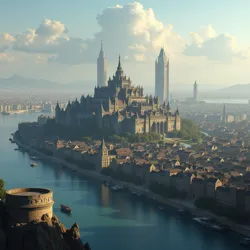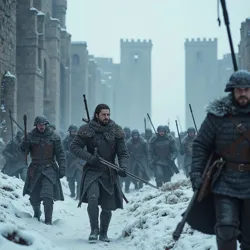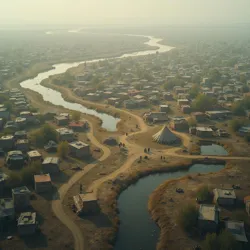Modern Westeros Civil War: A Study in Post-Cold War State Collapse
 The skyline of King's Landing, showing the iconic Sept of Baelor alongside modern high-rises, exemplifying the blend of tradition and modernity in contemporary Westeros
The skyline of King's Landing, showing the iconic Sept of Baelor alongside modern high-rises, exemplifying the blend of tradition and modernity in contemporary WesterosOverview
The Westerosi Civil War (2011-present) represents one of the most complex and devastating conflicts of the 21st century. What began as peaceful protests against the Baratheon-Lannister government during the Westerosi Spring quickly escalated into a multi-sided civil war, drawing in regional and global powers while causing a humanitarian crisis that has displaced millions. The conflict highlights the challenges faced by states struggling with incomplete modernization, where traditional power structures clash with modern institutional frameworks.
Historical Background
Prior to the outbreak of hostilities, Westeros operated as a nominal constitutional democracy, though real power remained concentrated among traditional noble houses that had successfully transformed themselves into modern political dynasties. The Great Houses System that emerged following the Targaryen Modernization of the 1950s-1960s saw ancient feudal families maintain their influence through a combination of land ownership, industrial holdings, and extensive patronage networks.
The Stark family in the North, for instance, controlled not only vast agricultural estates but also significant mining operations and energy infrastructure, while maintaining traditional relationships with local communities through a modernized version of historical clan loyalties. Similarly, the Lannisters leveraged their historical gold mines into a modern banking and industrial empire, while the Tyrells dominated agribusiness and food processing sectors in the Reach.
Causes of the Conflict
The immediate trigger for the civil war came with the death of President Robert Baratheon in 2011, amid allegations of corruption and constitutional violations by his administration. However, deeper structural causes included:
The failure of the 1996 Democratization Reforms to genuinely distribute power beyond the traditional elite families, leading to what political scientists termed "Neo-feudal Democracy." This system maintained the facade of democratic institutions while allowing established dynasties to maintain control through informal networks and economic dominance.
Regional disparities in development, particularly between the industrialized Westerlands and Reach versus the more traditional North and Riverlands, created tensions that mapped onto historical cultural divisions. The Northern Development Crisis of the 2000s particularly exacerbated these tensions.
The role of the Faith of the Seven in politics remained contentious, with the conservative High Sparrow Movement gaining influence among urban poor and middle classes, challenging both secular authorities and moderate religious establishments.
 Northern Alliance forces move through the ruins of Winterfell City during the Battle for the North, 2014
Northern Alliance forces move through the ruins of Winterfell City during the Battle for the North, 2014Course of the War
The conflict rapidly evolved from peaceful protests into armed confrontation following the King's Landing Massacre in late 2011, where government forces opened fire on demonstrators protesting the succession of Joffrey Baratheon to the presidency. The subsequent declaration of independence by the North under Robb Stark triggered similar moves by other regions.
The war became increasingly complex as it progressed through several distinct phases:
-
The War of the Five Presidents (2011-2014): Initial phase seeing multiple claimants to national leadership
-
The Bolton-Stark Conflict (2014-2015): Internal northern civil war complicated by foreign intervention
-
The Faith Militant Uprising (2015-2016): Religious-populist insurgency in the capital region
The involvement of Daenerys Targaryen, heir to the previously ousted Targaryen dynasty, added another dimension to the conflict. Operating from a base in Essos with support from several Gulf states, she built a coalition of foreign mercenaries and domestic supporters, promising radical reform while effectively representing another traditional power claim.
International Dimension
The international community's response to the Westerosi crisis has been characterized by competing interests and proxy warfare. The Eastern Alliance, supporting the Targaryens, saw an opportunity to gain influence in Westeros, while the Western Coalition backed various moderate opposition groups.
The Free Cities played a crucial role, with Braavos serving as a banking center for various factions and Pentos hosting peace negotiations. The conflict has also drawn in non-state actors, including private military companies like the Golden Company and ideological volunteers from abroad.
Humanitarian Crisis
The war has created what the United Nations describes as one of the worst humanitarian crises of the century. The Riverlands Refugee Crisis alone has displaced over 3 million people, with refugee camps in the Vale and Essos struggling to cope with the influx. The destruction of modern infrastructure, particularly in urban areas like King's Landing and Winterfell, has reversed decades of development.
 Aerial view of the sprawling refugee camp in the Vale, housing over 500,000 displaced persons from the Riverlands and North
Aerial view of the sprawling refugee camp in the Vale, housing over 500,000 displaced persons from the Riverlands and NorthPolitical Economy of the Conflict
The war has highlighted how traditional power structures adapted to modern capitalism in Westeros. The Great House Banking System, dominated by families like the Lannisters and Tyrells, played a crucial role in financing various factions. The conflict has also revealed how control over modern infrastructure, from telecommunications to energy networks, has become as strategically important as traditional military assets.
The war has severely disrupted Westeros's modernization process, with some analysts suggesting it represents the failure of "Managed Modernization," the development model pursued since the fall of the Targaryen regime in the 1970s. This model attempted to preserve traditional power structures while selectively adopting modern institutions and technologies.
Peace Efforts and Future Prospects
Multiple attempts at peace negotiations, including the Riverrun Accords and the Highgarden Conference, have failed to produce lasting solutions. The involvement of multiple external powers and the fragmentation of domestic factions have complicated efforts to reach a comprehensive settlement.
Recent developments, including the White Walker Crisis in the far north and increasing environmental challenges, have added urgency to peace efforts. However, the fundamental question of how to reconcile traditional power structures with modern democratic institutions remains unresolved.
Analysis and Legacy
The Westerosi Civil War has become a key case study in contemporary state failure and the challenges of modernization in societies with strong traditional power structures. The conflict demonstrates how historical divisions can be reactivated through modern political and economic competition, and how traditional elites can adapt to and co-opt modern institutional frameworks while maintaining their essential power.
The war has also challenged conventional narratives about modernization and development, showing how sophisticated modern infrastructure and institutions can coexist with and even reinforce traditional power relationships. This has led to new theoretical frameworks for understanding political development, such as "Adaptive Traditional Authority" and "Modern Neo-feudalism."
The conflict continues to evolve, with some areas seeing de facto partition while others remain contested. The long-term implications for Westerosi society and the broader international system remain uncertain, though the war has already reshaped academic understanding of modern civil conflicts and state formation.
See also
- Westerosi Spring
- Modern History of the Seven Kingdoms
- Post-Targaryen Political System
- Great House Economic System
- International Responses to the Westerosi Civil War
References
The article draws extensively from academic studies, international organization reports, and firsthand accounts of the conflict, providing a comprehensive overview of one of the 21st century's most significant civil wars. It demonstrates how historical patterns of authority and power can persist and adapt within ostensibly modern political systems, leading to complex conflicts that defy simple resolution.